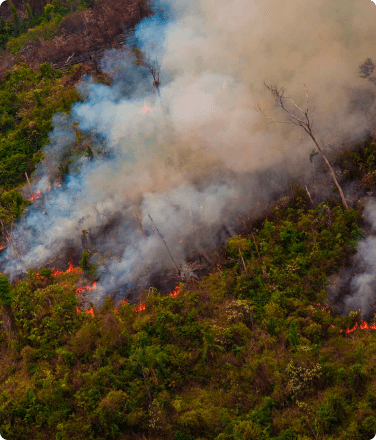Brazil Amazon Fires: 26 Million Acres Scorched in 2023, Up 35.4% from Previous Year
An area the size of the state of Tennessee burned in the Brazilian Amazon in 2023
While deforestation in the Amazon decreased significantly last year, the forest continued to burn at an alarming rate. For the first time since 2018, the clearance rate was less than 10,000 sq km in the 12 months until 31 July. Still more encouraging, the loss of tree cover in Indigenous territories fell by 73%. Despite these statistics, a staggering 26.4 million acres (10.7 million hectares) of Brazil’s Amazon rainforest burned in 2023—an area comparable in size to the U.S. state of Tennessee—according to MapBiomas Fire Monitor. This represents a 35.4% increase from the previous year.
On average close to 1 million trees are still being chopped down or burned every day in the Amazon. Countless more died because of the drought, and this will worsen the degradation of the forest. Overall, the Amazon was worse off in 2023 than the year prior.
The Impact of Climate Change, El Niño and Unprecedented Drought
In 2023, researchers’ forecasts came to fruition as the peak of the Amazon fire season aligned with an ongoing El Niño event—a climate phenomenon characterized by the warming of sea surface temperatures in the equatorial Pacific Ocean, which affects rainfall patterns in the Amazon. This perilous combination led to drier conditions, thereby intensifying forest fires.
Indeed, in 2023, the Amazon experienced the most severe drought in its recorded history, with rivers dropping to record lows, adversely affecting communities and endangering wildlife.
While El Niño significantly contributed to the reduction in rainfall, thereby exacerbating the 2023 drought, preliminary scientific analyses have determined that the drought’s extreme severity was mainly due to high temperatures associated with climate change. The probability of such an extreme drought occurring was increased thirtyfold by the climate crisis.
This convergence of climate change, unprecedented temperatures, extreme drought, deforestation, and wildfires underscores the growing concerns for the Amazon’s future.
Amazon fires made global headlines in 2019—four years later were they as bad?
Unfortunately, they were.
In August 2019, massive smoke plumes drifted thousands of miles from the burning Amazon and settled over Sao Paulo, Brazil’s largest city, blocking out the sun. The world’s attention focused on Jair Bolsonaro’s administration as he opened the Amazon for further exploitation by incentivizing land invasions, mining, ranching, and large-scale agriculture, the primary drivers of tropical forest fires.
Despite international pressures, the situation has continued to deteriorate.
Deforestation in the Brazilian Amazon fell by 50% in 2023 compared to the previous year. However, the burned area increased by 36%, with approximately 26.6 million acres burned in 2023 compared to 19.5 million acres in 2022. President Lula da Silva’s efforts to restore environmental protections dismantled by Bolsonaro have achieved some positive results. But Lula’s administration—weakened in the face of a conservative Congress—has been unable to prevent the passage of legislation that continues to dismantle environmental safeguards and Indigenous peoples’ rights in favor of agribusiness interests. The future of the Amazon hangs in the balance.
The Impact of Climate Change, El Niño and Unprecedented Drought
The peak of the 2023 Amazon fire season coincided with an El Niño event, leading to drier conditions and intensified forest fires. The Amazon experienced its most severe drought in recorded history, with rivers dropping to record lows, affecting communities and wildlife.
While El Niño reduced rainfall and exacerbated the drought, high temperatures linked to climate change were the main cause. The probability of such an extreme drought was increased thirtyfold by the climate crisis.
This convergence of climate change, extreme drought, deforestation, and fires underscores the growing concerns for the Amazon’s future.







